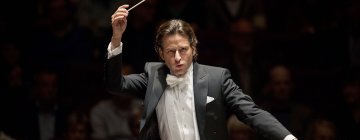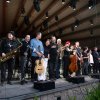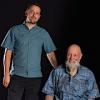There have now been two major celebrations of minimalist pioneer Terry Riley’s 90th birthday in Southern California this summer, covering the extreme ends of his long career.
Back in June, the Ojai Music Festival served up a generous helping of recent and ongoing compositions that indicated where Riley is today. At The Ford on Sunday evening (Sept. 7), we hurtled back in time with members of the Bang on a Can All-Stars and several friends to the 1960s to purportedly hear how Riley originally broke through. Accordingly, there was nostalgia in the air, but also the realization that time doesn’t stand still in Riley’s world.
The turnout at The Ford — which looked like a sold-out house (a capacity of 1,200 seats) to this practiced eye — was an eclectic blend of young, old, and those in between. Striking posters of the grand old guru of new music were given out for free to the first 500 people through the gates. Now living in Japan, Riley couldn’t make the trans-Pacific trip, but his presence hovered over the old amphitheater as he introduced the concert via a recording.
Riley’s Keyboard Study No. 2 found pianist Vicky Chow opening with a simple, revolving hard-core minimalist four-note riff. But when the “tape loops” kicked in, the texture became more complex and blurred, gradually assuming a funky groove as it changed shapes continuously until the end. There’s no point in figuring out a structure for this music; just sitting back and letting it flow unlocks its pleasure cells.
On, then, to the piece that unlocked Riley’s music for many a young person back in the day — myself included: A Rainbow in Curved Air. The caveat is that this was not quite the wondrously floating Rainbow that was on the Columbia LP; rather, it was the West Coast premiere of Gyan Riley’s celebration of his father in the form of an “arrangement” that at times amounted to a recomposition.
While Chow, on a Nord synthesizer, sounded the familiar electric organ riff that opens Rainbow, the piece quickly turned into a carefully structured rock-out for keyboard, clarinet, cello, drum set, and Gyan’s electric guitar, creating a sound that seemed to pay homage to the music that Rainbow eventually spawned. At times, when Gyan played some heavily processed solos and power chords as the drums thundered away, the music sounded like a tribute to The Who and Pete Townshend in particular. Townshend’s aptly named song “Baba O’Riley” is threaded with an electronic loop directly influenced by Rainbow.
This arrangement is too highly structured to flow like Terry’s original, but the performance often had the vitality and drive of a good jazz-rock jam session. Terry’s voice could be heard peeking through the music, announcing the end of all wars while picturing a utopia on earth free of the Pentagon and politics. Now we were really back in the 1960s.
It was inevitable that the grand finale would be a rendition of the ever-variable, ever-startling In C, the piece that lit the fuse in 1964 for the minimalist revolt. This performance of In C, for 15 players of diverse instruments, lasted exactly 61 minutes, one of the lengthier performances of this new-music standard that I’ve experienced over the years.
Unfortunately, the amplified sound was congested and, unintentionally or not, plagued by feedback. There was an Indian contingent in the ranks up front consisting of Salar Nader (tabla) and Rajib Karmakar (electric sitar), but the latter was completely inaudible except in a handful of spots where the textures thinned out. Various faux-psychedelic lighting patterns revolved in back of the band — sometimes hokey, sometimes cool.
Yet despite the sonic obstacles, the performance had an organic ebb and flow to its shifting textures, with periods of pastoral near-stasis and roaring unison coalitions of sound. Like every performance of this piece, it was, by design, one of a kind.




